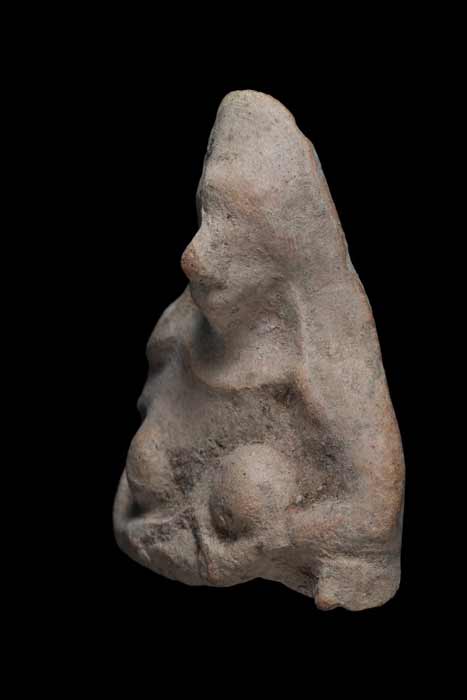A rare 2,500-year-old fertility goddess amulet has been unearthed in Israel’s Negev Desert, not by archaeologists, but by a boy on holiday. Dating to the 5th or 6th century BC, known to historians as ‘the Late Temple period,’ the bare-breasted female fertility goddess figure is thought to have served as a protection amulet for assuring good luck and prosperity to its wearer. What is unusual in this story, however, is that the discoverer of the rare treasure, that dates to a time the region was under Persian control, was Zvi Ben-David, an 11-year-old boy who was on family vacation when he found the rare artifact.
Finding And Confirming The Rare Fertility Goddess Amulet
Zvi Ben-David was on a trip with his family to Nahal Besor in the Negev Desert when he caught sight of what he describes as “an unusual object.” Ben-David’s mother, Miriam Ben-David, is a professional tour guide and she immediately realized the significance of her son’s discovery and contacted the Israeli Antiquities authority (IAA). The discovery has now been confirmed: the archaeologists measured it at about “seven centimeters (2.7 inches) tall and six centimeters (2.3 inches) wide.”

The fertility goddess amulet found by the 11-year-old boy in the Negev region of Israel, which is seven centimeters (2.7 inches) tall and six centimeters (2.3 inches) wide. ( IAA)
The fertility goddess ’ breasts are bare, and her hands are tucked underneath her cleavage to make them more pronounced, and her head and neck are covered with a scarf.
According to an article in the Daily Mail archaeologists in Israel think the 2,500-year-old amulet was perhaps used as protection for an infant during pregnancy. Furthermore, they say this particular fertility relic is “so rare only one other similar one has ever been found.” It was probably molded during the Iron Age , sometime in the fifth or sixth century BC.
To commemorate his discovery of the ceramic fertility goddess amulet Zvi Ben-David was issued a certificate of appreciation from the IAA.

Zvi Ben-David was on a family holiday when he discovered the priceless fertility goddess amulet. ( IAA)
The Priceless Amulet Was Made During The Achaemenid Period
Archaeologist Oren Shmueli and IAA curator Debbie Ben Ami said the goddess was created at the end of the late First Temple period when Israel was governed by the Achaemenid Empire from Persia. While clay figurines of bare-breasted women were common in the ancient Middle East, often used to invoke prosperity or good luck, according to the Smithsonian the archaeologists believe this particular type of molded amulet was used for “protection during a pregnancy or for an infant, like the hamsa [Hand of Fatima] symbol today.”
What is perhaps most interesting about the amulet is that it directly contravenes ancient Israelite traditions, since it was forbidden to worship idols. However, with a third of children dying in childbirth, such amulets seem to have been permitted, most likely appealing to the fertility goddess to assure a safe birth and recovery for the mother, whose lives were also seriously endangered when giving birth.

The frontal view of the molded fertility goddess amulet clearly showing her crossed arms beneath her breasts. ( IAA)
Protecting Mothers And Children On Their 3:1 Death Gamble
Don’t think for a second that just because modern religions have de-powered most of the ancient fertility goddesses that the dangers of childbirth have gone away. For most of our history, pregnancy and childbirth were seriously dangerous for both baby and mother and while improvements in healthcare, nutrition, and hygiene mean maternal deaths are much rarer today, your safety as a pregnant mother greatly depends on where you live.
According to the World Health Organization “more than 300,000 women died from pregnancy-related causes in 2015.” That ’s 830 women every day. Two-thirds of these deaths (201,000) occurred in Sub-Saharan Africa and 22% (66,000) occurred in South Asia. While a major factor is simply that more babies are born in Asia and Africa than in other regions in the world there is still a vastly higher maternal mortality rate than is found in higher-income countries. An example of this problem is that, per birth, a woman in Nigeria is “more than 200 times more likely to die in pregnancy or childbirth than a woman in Sweden.”
It is perhaps time the fertility goddess was resurrected, until these horrendous statistical realities are pulled into line.
Top image: Zvi Ben-David, the boy who found the rare fertility goddess amulet in southern Israel, holding his certificate of appreciation from the IAA. Source: IAA
By Ashley Cowie
Related posts:
Views: 0
 RSS Feed
RSS Feed

















 March 16th, 2021
March 16th, 2021  Awake Goy
Awake Goy 


 Posted in
Posted in  Tags:
Tags: 
















